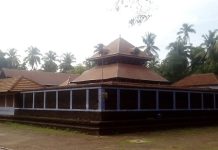Ernakulam Shiva Temple, also known as Ernakulathappan Temple, stands as a prominent shrine in the heart of Ernakulam, Kerala, India. This sacred edifice is dedicated to Lord Shiva and is affectionately referred to as the “City Temple” by locals. It is believed that Lord Shiva, in his role as Ernakulathappan, serves as the guardian and protector of the city. This temple has deep historical roots, dating back to the era of the Kochi Maharajas. Today, it is under the administration of the Cochin Devaswam Board, and its grandeur and significance make it one of the major Shiva temples in Kerala.
Legend:
The temple’s legend intertwines with the epic Mahabharata. According to the story, Arjuna, one of the Pandava brothers, sought to appease Lord Shiva through intense penance. Touched by Arjuna’s devotion, Lord Shiva, accompanied by his consort Parvathi, set out to meet him. To test Arjuna’s devotion, Shiva assumed the form of a tribal hunter named Kiratha.
During their encounter, a wild boar charged toward Arjuna, and both he and Kiratha (Shiva) shot arrows at the beast. A dispute arose over who had killed the boar, leading to a fierce battle between Arjuna and Kiratha. Ultimately, Kiratha emerged victorious.
In an act of reverence, Arjuna molded a Shiva Linga out of mud and began offering flowers in worship. To his astonishment, the flowers he placed on the Linga landed on Kiratha’s head. Arjuna realized that Kiratha was indeed Lord Shiva in disguise. Pleased by Arjuna’s sincerity and devotion, Lord Shiva granted him the Pashupatha Arrow, a powerful weapon.
Centuries later, a man named Rishi Nagam, who had been cursed to take on a snake-like form, discovered the Linga Arjuna had created, buried in the mud. Rishi Nagam worshipped this Linga, hoping to break his curse. Lord Shiva and Parvathi, impressed by his devotion, appeared before him, released him from the curse, and manifested a new idol near the original Linga. This event led to the temple’s establishment, known as Rishnagakulam.
History:
The Ernakulam Shiva Temple’s history is deeply intertwined with the Chera Dynasty, which regarded it as one of its major temples. After the Chera Dynasty, the temple came under the patronage of local Nair nobles and became part of the Kochi Kingdom’s territory. When the Dutch besieged Fort Kochi in the 17th century, the Kochi rulers shifted their capital to Ernakulam and established a palace nearby, further elevating the temple’s importance.
In 1842, Diwan Sri Edakkunni Sankara Warrier initiated the renovation of the temple, which was in a dilapidated state. The renovation, completed in 1846, included the construction of two traditional Kerala-style Gopura Mandapams (Entrance Towers) and elevated the temple’s status to that of a royal temple within the Kochi Kingdom. Over time, the temple came under the administration of the Cochin Government’s Devaswom Board, which later became part of the Indian Union’s control in 1949.
Architecture:
The Ernakulam Shiva Temple showcases exquisite Kerala temple architecture. The sanctum complex is circular with finely sculpted walls, and the roof is adorned with copper tiles. The temple features two gates: the western Gopuram, a two-story structure in typical Kerala style with gabled roofs and slanting windows, and the recently renovated eastern Gopuram, mirroring the western design.
In addition to the main temple, the complex includes a marriage hall, a dining hall (Oottupura), and separate temples for Lord Muruga and Lord Hanuman, constructed in Tamil and Udupi Madhwa Sampradaya styles, respectively. A sacred pond and a 200-year-old banyan tree add to the temple’s serene surroundings.
Festivals:
The Uthsavom (temple festival) of the Ernakulam Shiva Temple is a grand celebration, typically held during the Makaram month. The festivities commence with Kodiyettam, the hoisting of the temple flag, and culminate with the Arattu procession, where the deity is ritually bathed in a nearby temple tank. The festival features caparisoned elephants, Panchavadyam (traditional music ensemble), Pandimelam, and colorful fireworks.
Throughout the festival, temple arts like Ottamthullal, Paatakam, Thayambaka, Kathakali, classical dances, classical music concerts, and Bhajans are performed. Devotees and visitors alike flock to the temple to witness these captivating cultural events.
Temple Timings:
The Ernakulam Shiva Temple is open from 3:00 AM to 11:00 AM in the morning and again from 4:00 PM to 8:00 PM in the evening.
How to reach Ernakulam Shiva Temple
Ernakulam Shiva Temple, also known as Ernakulathappan Temple, is located in the heart of Ernakulam, Kerala, India. It is easily accessible by various modes of transportation. Here are some common ways to reach the temple:
By Air:
The nearest airport to Ernakulam is Cochin International Airport (COK), which is well-connected to major cities in India and international destinations. From the airport, you can hire a taxi or take a pre-paid cab to reach the temple. The airport is approximately 30-35 kilometers away from the temple, and the journey takes around 45 minutes to an hour, depending on traffic conditions.
By Train:
Ernakulam has two major railway stations – Ernakulam Junction (Ernakulam South) and Ernakulam Town (Ernakulam North). Both stations are well-connected to various parts of India. The temple is a short drive away from these railway stations. You can easily hire a taxi or take an auto-rickshaw to reach the temple.
By Bus:
Buses to Ernakulam are available from cities such as Bangalore, Chennai, Mangalore, Salem, Coimbatore, Madurai, and major towns within Kerala. Most long-running buses pass through MG Road, and the nearest bus stops to the temple are ‘South’ and ‘Pallimukku.’ The KSRTC bus station, a major transportation hub, is located approximately 2 kilometers away from the temple, where travelers can easily find local transportation options like auto-rickshaws or taxis to reach the temple.

























































